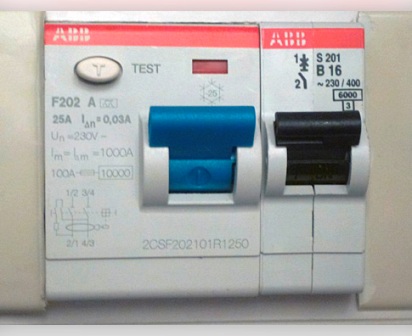Protection against indirect contact
Standards and regulations distinguish between two types of hazardous contact: direct and indirect. In this article, we will focus on protective measures against electric shock from indirect contact.
Indirect touch means human contact with an open conductive part of the equipment, which in the normal operation of the electrical installation is not under voltage, but for some reason turned out to be under voltage, for example, due to insulation failure. In this case, accidental contact of a person with this part can be extremely dangerous, since current will flow through the person's body.
For protection against indirect contact, to prevent electric shock to people or animals in case of insulation failure, special measures are used, separately or several of them at once:
-
protective earthing;
-
automatic power off;
-
equalization of potentials;
-
equalization of potential;
-
double or reinforced insulation;
-
ultra-low (low) voltage;
-
protective electrical separation of circuits;
-
insulating (non-conductive) rooms, areas, platforms.

Defense land
To ensure electrical safety, protective earthing of the equipment is carried out. This grounding is different from functional grounding and involves connecting conductive, potentially hazardous equipment to a grounding device.
The function of protective earthing is to eliminate the danger to a person standing on the ground and touching a part of the equipment that has been energized due to a short circuit. All potentially hazardous conductive parts of the equipment are connected to earth through earthing devices connected to a grounding conductor. By protective earthing, the voltage of the earthed parts is reduced to a safe value with respect to earth.
Protective earthing applies to equipment operating at voltages up to 1000 volts:
-
to single-phase, isolated from the ground and to three-phase with isolated neutral;
-
to equipment operating in networks with a voltage of more than 1000 volts with a grounded neutral and an isolated neutral.
An artificially grounded conductor (artificial grounded electrode) or some conductive object located in the ground, for example, a reinforced concrete base (natural grounded electrode), can serve as a grounding conductor for protective grounding. Communication lines, such as sewage, gas or heating lines, should not be used for this purpose.
Automatic shutdown
In order to protect against electric shock with indirect contact, an automatic shutdown is carried out by opening several phase conductors at the same time, and in some cases also a neutral conductor. This method of protection is combined with earthing and neutralization protection systems. It is also applicable in cases where it is impossible to apply protective earthing.
This method of protection refers to high-speed systems that can disconnect equipment from the network in less than 0.2 seconds in the event of a dangerous situation. It is recommended to implement protective shutdown of hand power tools, mobile electrical installations, household electrical appliances.
When the phase is closed to the box, or the insulation resistance to ground drops significantly, or when a live part comes into contact with the human body, the electrical parameters of the circuit change and this change is a signal for RCD trippingconsisting of a residual current device and a switch. The residual current device registers changes in circuit parameters and sends a signal to the switch, which in turn disconnects the dangerous device from the network.
RCDs for protection against indirect contact can respond to different parameters: to short-circuit currents in the neutralizing system or to differential current, to body voltage to ground or to zero-sequence voltage. These RCDs differ in the type of input signal. In equipment with automatic RCDs, after registering an emergency situation, potential equalization is applied, after which the power supply is turned off.

Potential equalization
If in the same electrical network there are several electrical installations, some of which are grounded through a separate earthing device without connection to the PE wire, and some equipment is connected to the PE wire, this condition is dangerous and it is prohibited to ground electrical installations in this way .Why? Because if one phase is short-circuited to the body of, say, a motor grounded by a separate earth, then the bodies of grounded electrical installations will be energized relative to earth. Remember that grounding is the connection of non-current-carrying metal parts of an electrical installation with the neutral conductor of the network.
The danger here is that equipment with properly organized protection will be energized. The tragic experience of the livestock industry shows that such improper grounding of equipment has led to mass deaths of animals.
To avoid such hazards, equipotential bonding is applied. The conductive parts of the protected equipment are connected so that their potentials are the same, thus ensuring the electrical safety of the network in case of indirect contact.
According to PUE, electrical installations for voltages up to 1000 volts are interconnected neutral shielded PEN or PE conductor supply line of TN system with earthing conductor of the earthing device IT and TT systems and with earthing earthing device at the entrance of the building.
Metal communication pipes of the structure, conductive parts of the building frame, conductive parts of centralized air conditioning and ventilation systems, grounding devices of the lightning protection system 3 and 2 cat., conductive sheaths of telecommunication cables, as well as functional grounding, if there are no PUE restrictions, are also linked here. The equipotential bonding wires from all these parts are then connected to the main ground bus.
Potential equalization
Potential equalization can significantly reduce the voltage of the step on the surface of the ground or floor by using protective conductors that are laid in the ground, in the floor or on their surface and connected to the grounding device. In some cases, a special ground cover is used. Potential equalization can be considered as a special case of equalization if we consider the conductive floor as a third-party conductive part in an electrical installation together with metal structures and pipelines.
Double or reinforced insulation
For protection against indirect contact in electrical installations with a voltage of up to 1000 volts, double insulation is used. The main insulation is protected by independent additional insulation. In case of damage to the additional insulation, the main insulation is protected.
Reinforced insulation is similar in its protective function to double insulation, its degree of protection corresponds to double insulation.
Conductive parts of electrical installations with double protective and reinforced insulation are not connected to either the protective conductor or the equipotential bonding system.
It will be pertinent to note here that power tools and hand held electric machines according to the class of protection against electric shock are divided into four classes: 0, I, II, III. Next, we'll look at some of the details of the protections implemented in them.
Class 0. Basic insulation provides protection against electric shock. In case of insulation failure, the isolation rooms, isolation areas, platforms, isolation floors are protected from indirect human touch.An example of this is a drill, the metal body of which does not have a grounding contact, and the plug is double-pole. Between the cable and the housing, where the cable enters the housing, a rubber grommet should be placed to provide insulation.
Class I. The basic insulation provides protection against electric shock while exposed conductive parts are connected to the PE conductor of the network, for example washing machines with a 3-pole Euro plug are protected in this way.
Class II. Double or reinforced casing insulation. An example of this is the plastic housing of an impact drill with a 2-pole plug and no ground.
Class III. The supply voltage is not dangerous for people. This is the so-called extremely low (low) voltage. An example of this is a household screwdriver.
Low (extremely low) voltage
The low or in other words extremely low voltage is in itself a protection against indirect contact. In combination with protective electrical circuit separation, for example by means of an isolating transformer, the safety is just as high. Low-voltage circuits are separated from high-voltage circuits, and in cases where extremely low voltage is higher than 60 volts DC or higher than 25 volts AC, additional measures are applied: insulation, sheathing.
The use of extremely low voltage in electrical appliances allows you to abandon the protective grounding of their conductive housings, except for situations of forced connection with conductive parts of devices with dangerous voltage. If low voltage is used in conjunction with automatic shutdown, then one of the terminals of the source is connected to the protective conductor of the network that supplies this source.
Protective electrical separation of circuits
In electrical installations with a voltage of up to 1000 volts, protective electrical separation of circuits is applied. By means of reinforced or double insulation or basic insulation and a protective conductive screen, some live parts or circuits are separated from others. The peak voltage of the isolated circuit must not be higher than 500 volts. The protective electrical separation of circuits takes place, for example, in an isolation transformer. Live parts of the supplied circuit shall be placed separately from other circuits.
Electrical separation of circuits significantly increases the safety of long-distance networks, thanks to isolation transformers. Sections of networks isolated from the ground and of short length differ in insignificant electrical capacity and high insulation resistance compared to the entire branched network. In case of indirect contact, a small current will flow through the human body from phase to earth. A separate section of the circuit is found to be safer with this separation.
Isolation (non-conductive) rooms, areas, platforms
Significant electrical resistance of walls and floors of some rooms, areas, sites, provides sufficient protection against indirect contact even in the absence of grounding of conductive parts of electrical installations with a voltage of up to 1000 volts. Isolation rooms are used to protect people from indirect contact in cases where other methods of protection are inapplicable or impractical.
However, there is an important condition: when the voltage of the electrical installation is more than 500 volts, the resistance of the insulating walls and the floor to the local grounding must not be lower than 100 kΩ at any point in the room and at voltages up to 500 volts, at least 50 kΩ. Isolated rooms do not imply the presence of a protective conductor, therefore, in all ways, the deviation of the potential from the outside to the conductive parts of the area is excluded in them.
